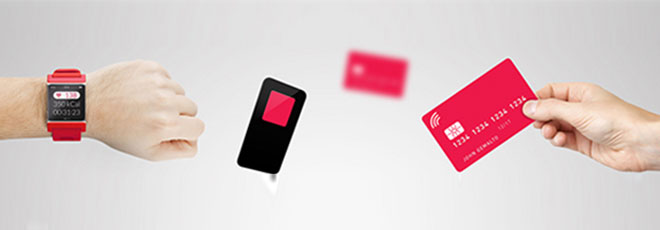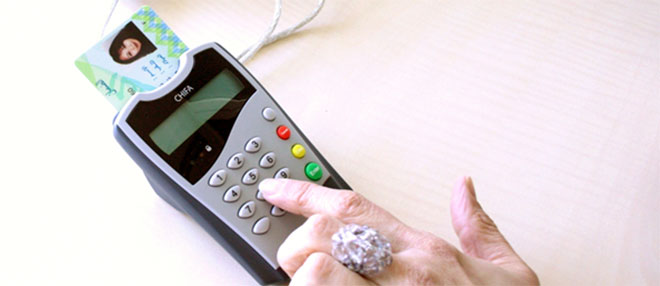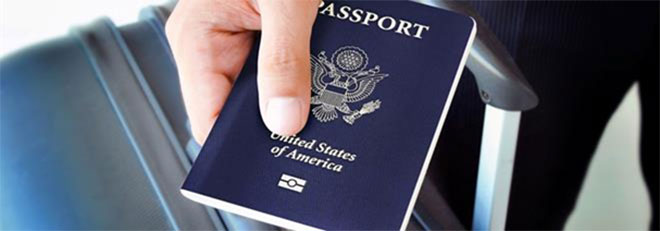Smart card basics – A short guide (2020)

Want to know more about smart cards?
Then you're in the right place.
In this dossier, you'll discover key facts about smart cards:
What is a smart card?
Smart card markets, size, and value
A short history of smart cards
What are the features and benefits of smart cards?
Smart card use cases
The key role of standards
What is a multiple application card?
What is the cost of a smart card?
Let's dive right in.
What is a smart card?
Let's start with a definition: a smart card is a small portable computer, usually the size of a credit card, without a display and a keyboard.
It integrates a microprocessor, some memory, and some apps.
The circular metal contact is vital to connect to the chip below and activate the card electrically.
It's used in conjunction with a contact or contactless card reader (POS for payments, at the ATM, or even in your mobile phone).
Why?
The card reader (or mobile phone) brings the 3V or 1.8 voltage to activate the chip.
30 to 50B smart cards in circulation today
Smart cards – in the form of credit cards and SIM cards - are the most common form of IT processing power on the planet.
It's is estimated that between 30 to 50B smart cards are in circulation today.
The smart card has a microprocessor or memory chip embedded in it that, when coupled with a smart card reader, has the processing power to serve many different applications.
In the last three decades, these tools, more than any other technology, have quietly taken us all into a virtual world.
Smart credit cards mediate daily transactions worth trillions of dollars.
SIM cards facilitate billions of conversations that bind together our social and economic worlds.
As an access-control device, smart cards (company badges, university IDs) make personal and business data available only to the appropriate users.
As a National eID card, residence permit, or electronic passport, smart card technology offers stronger identification and authentication tools for the benefits of both authorities and citizens.
As a driver's license or a tachograph card, the technology contributes to road safety.
Over 10 billion smart cards to be shipped in 2020
According to Eurosmart, smart card markets will exceed 10 billion units in 2019 and 2020 and reach 10382 million units.
The overall market is stable in 2019 (+0,1%) and 2020 (+1,4%) reflecting a mature market.
2020 market share forecasts
Telecom (SIM cards) accounts for 52% of the total market,
Payment and banking cards for 32%,
Government (eIDs and e-passports) and healthcare for 6%,
Device manufacturers for 5%: mobile phones, tablets, navigation devices and other connected devices including an embedded secure element without SIM application,
Others for 5%: cards issued by operators, for transport, toll or car park services; cards for pay-TV; physical and logical access cards.
Major trends for 2019 and 2020
The device manufacturer segment (OEM) is expected to be very dynamic with a +7,5% boost
The government and healthcare segment is also expected to grow fast in 2020 (+7,4%), driven by many ID programs around the world.
Financial services will still grow by +6,3% in 2020 after a +24,4% increase in 2019.
The contactless interface has become the leading choice for financial services and governments.
A $21B market in 2023
According to Markets and Markets' recent research report, the smart card market value is expected to reach $21.57 billion by 2023.
Currently, smart cards and card readers account for more than 75% of the market.
The related market for software comprises management system software and databases. Consulting, support, and maintenance services are also crucial.
The Asia Pacific is expected to take the largest share of the market, as reported by the same study.
Prominent players in these markets are Gemalto (now part of THALES), Giesecke & Devrient, and IDEMIA (formerly Oberthur Technologies and Morpho), to name a few.
Major smart card microprocessor vendors are Infineon Technologies, NXP Semiconductors, Samsung, and STMicroelectronics.
What is the history of smart cards?
Roland Moreno patented the memory card in 1974.
By 1977, three commercial manufacturers Bull CP8, SGS Thomson, and Schlumberger, started developing smart card products.
In March 1979, Michel Hugon from Bull CP8 was the first to design and develop a microprocessor-based card combining a processor and local memory. He invented the computerized smart card.
1979: early developments for the banking sector
1995: first SIM cards
1999: first national eID card (Finland ID)
1999: first smart cards for transport
2001: The Department of Defense first issuedMilitary CAC credentials for physical access control and secured logical authentication
2003: Micro-SIM launched
2005: first ICAO-compliant electronic passport (Norway passport)
2012: Nano-SIM introduced
2018: first biometric contactless payment card, eSIM launched (thickness is <1 mm or 0.039 in)

About smart cards and Green IT technologies
Smart card technology is an exemplary Green IT tool.
It is a very familiar portable object with a rather long life-cycle (3 to 10 years) and an extremely low carbon footprint (equivalent to less than 1 mile done by car per card manufactured).
There's more.
It has a low electric consumption (only seconds and when in use) and can be available en masse and at a very reasonable cost per unit.
We promote the use of organic and/or non-toxic alternative materials such as polylactic acid for eco-friendly banking cards or SIM cards and polycarbonate for ID or health cards.
Smart card dimensions and major standards
The ISO/IEC 7810 ID-1 standard defines, in particular, the usual size of an ID card.
The ID-1 size is 85.60 × 53.98 mm (3 3⁄8 in. × 2 1⁄8 in.) and rounded corners with a radius of 2.88–3.48 mm.
This format is being used for PET, PVC, eco-friendly PLA, polycarbonate, or even full metal cards.
It is used for IDs, driver licenses and health cards in many countries.
Credit card dimensions (with or without a chip) are the same with a thickness of 0,03 inch or 0,76 mm.
SIM cards have different formats: Standard SIM (15 x 25mm), Micro SIM (12 x 15mm), Nano-SIM (8.8 x 12.3mm), embedded SIM or eSIM (5 x 6 mm and 1 mm thick).
ISO/IEC 7816 is an international standard related to electronic identification cards with contacts, especially smart cards, managed jointly by the International Organization for Standardization (ISO) and the International Electrotechnical Commission (IEC).
ISO/IEC 14443 defines the standard for contactless cards.
What are the features of a smart card?
Smart cards provide ways to securely identify and authenticate the holder and third parties who want to gain access to the card. A PIN code or biometric data can be used for authentication.
They also provide a way to securely store data on the card and protect communications with encryption.
Smart cards provide a portable, easy to use form factor.
Smart cards are being used for secure online authentication at the Surrey Memorial Hospital near Vancouver in Canada.
What are the benefits of a smart card?
Smart cards contain unique features that bring many benefits to both consumers and issuing organizations.
Smart cards provide:
Security (the physical layout of the chip is designed to be tamper-resistant, and a large portion of the operating-system code is dedicated to security.)
Confidentiality (the card and its data are with you, and YOU decide what to do with them.)
Portability (you carry it in your wallet or phone.)
Convenience (a consequence of all the above)
Smart cards offer more security and confidentiality than other financial information or transaction storage vehicles, making it a perfect solution for e-commerce transactions.
As they include a tamper-resistant microprocessor, they have interesting processing power to protect the information, encrypt and execute instructions from specific programs. Here's where smart cards have a massive advantage over magstripe cards.
Can you imagine a portable vault?
You have it.
A smart card is a safe place to store valuable information such as private keys, account numbers, passwords, or personal information.
It's also a secure place to perform processes that one doesn't want to be exposed to the world, for example, performing a public key or private key encryption.
The benefit of the smart card is that you can verify the PIN or fingerprint securely, off-line.

From left to right: online authentication access (with the US military smart badge), secure transaction with an EMV card (a biometric touch sensor), strong identification with your national ID card.
What are the types of smart cards?
To begin with, magnetic stripe cards are definitively not smart cards.
Memory vs microprocessor
Smart cards come in two varieties: memory and microprocessor.
Memory cards simply store data and can be viewed as a small USB memory stick with optional security. A microprocessor card, on the other hand, can add, delete, and manipulate information in its memory on the card.
Similar to a miniature computer, a microprocessor card has an input/output port operating system and a hard disk with built-in security features.
Contact vs contactless
Smart cards have two different types of interfaces: contact and contactless.
Contact smart cards are inserted into a smart card reader, making physical contact with the reader.
However, contactless smart cards have an antenna embedded inside the card that enables communication with the reader without physical contact. You tap and pay.
The standard for contactless smart card communications is ISO/IEC 14443 and allows for communications up to 10 cm (3.9 in).
A combi card combines the two features with a very high level of security.
Do you want to know why contactless is safe?
How are smart cards used?
The scope of uses for a smart card has expanded each year to include applications in a variety of markets and disciplines.
In recent years, the information age has introduced an array of security and privacy issues that have called for advanced smart card security applications.
Here are some smart card examples:
Information Technology
Businesses, the government and healthcare organizations continue to move towards storing and releasing information via networks, Intranets, extranets, and the Internet.
These organizations are turning to smart cards to make this information readily available to those who need it, while at the same time protecting the privacy of individuals and keeping their informational assets safe from hacking and other unwanted intrusions.
In this IT area, smart cards enable:
Secure login and authentication of users to PCs and networks,
Secure B2B and B2C e-commerce,
Storage of digital certificates, credentials, and passwords,
Encryption of sensitive data.
Mobile Telecommunications
Subscribers using the Global System for Mobile communications (GSM) standard for mobile phones use smartcard technology asSIM cards. The smart card is inserted (removable SIM) or integrated (eSIM, M2M SIM) into the mobile handset or theM2M module. The card stores personal subscriber information and preferences that can be PIN code protected and transported from phone to phone. The SIM cards enable:
Secure subscriber authentication,
International roaming across networks,
Secure mobile value-added services.
SIM cards have been regularly evolving to deliver each new generation promise, from 2G to 5G (5G SIM).
Wireless providers benefit from reduced fraud thanks to the security offered by smart cards. With the advent of mobile services such as mobile commerce, Internet browsing, and information services, wireless providers rely on smart cards to act as the security mechanism to protect those services and ensure trust.
Commercial Applications
Smart cards also provide benefits for a host of business applications in both B2B and B2C environments. The smart card's portability and ability to be updated make it a technology well suited for connecting the virtual and physical worlds, as well as multi-partner card programs.
The cards store information, money, and/or applications that can be used for:
Banking/payment
Loyalty and promotions
Access control
Identification
Ticketing
Parking and toll collection
TheEMV payment standard had a powerful impact on smart payments worldwide. No matter which payment method is used, EMV affords the added security of credit cards remaining in possession of the cardholder throughout the entire transaction. With EMV, the computer chip inside the credit card is an active part of the transaction, unlike the magstripe, which is passive.
As of late 2015, all major U.S. payment brands have been moving from magnetic stripe cards to the global standard for payments, chip-basedEMV cards.
In India, the deadline for the EMV migration for bank cards was set on December 31, 2018.
Over 8.2 billion EMV payment cards are in circulation worldwide as of early 2019.
Learn more on EMV in 3 minutes with our EMV smart card web dossier.
There's more.
Multiple applications can be stored on the card, enabling partnering on card programs and providing added convenience to the cardholder. (Payment, loyalty, transport, eID, electronic signature...)
In Spain, Portugal, and Latin America, over 9 million university students are using a Student Smart Card developed by Banco Santander in 279 universities.
The University Card is an ID, an access card, a payment card, and a wallet.

The Algerian health program uses smart health cards for patients (here in a reader) and smart USB tokens (with a chip) for health professionals. Discover the benefits of health cards in universal health care systems.
Electronic IDs
An electronic ID (e-ID) card fulfils various roles: it acts as a traditional means of identification, as a travel document, and finally, as a passkey to citizen's data.
Many international regulations and standards have been established on e-ID, most of which are applied by States.
The public has become accustomed to computerized smart cards through their use in the banking system, and as a result, their reliability is no longer questioned.
National ID cards are now also being used as a means of accessing an array of services that were previously difficult to synchronize.
The e-ID card (aka computerized National identity cards) can be used for identification, but also authentication and electronic signature. Thus, this system enables several previously complex information paths to be simplified.
It can be used as:
A representation of sovereign authority, certifying that the holder is in a legitimate legal position to his or her national jurisdiction.
A means for citizens to access services and exercise their rights and duties to the public authorities.
A genuine seal of authenticity that the citizen can use to authenticate his or her actions regardless of the exchange formats and media used, since the data used to ensure security and trust also guarantee the legal validity of any transactions certified in this way.
Health and health insurance cards
Health cards, including a microprocessor, also act as a significant component of an IT system. They identify the holder and his/her affiliation to an organization, and by verifying his/her rights.
These cards are widely used. Every French and German citizen has a smart card for health insurance.
Unlike paper documents, which can easily be forged, they are tamper-proof devices challenging to reproduce or unlawfully manipulate.
Electronic and biometric passports
Migration to electronic passports has been in progress since 2005. Over1 billion e-passports are now in circulation, and more than 150 states have started issuing this new type of travel document in mid-2018.
The electronic passport integrates smart card technology with a microprocessor which stores a digital version of the ID photo as well as all of the ID data found on the first page of the paper passport.

Is my passport an electronic one? Yes, the symbol printed at the bottom of the front page indicates that the U.S. passport contains a microprocessor. They were first issued in 2006.
The ICAO (International Civil Agency Organization) 9303 standards have been key for the international deployment of biometric identification and electronic storage of data in so-called machine readable travel documents (MRTDs).
Why are other countries ahead of the U.S. in applying smart card technology?
Card issuers in different countries are building their business case to justify the issuance of smart cards for various reasons.
In the U.S. the fraud liability shift (EMV liability shift) ran into effect in late 2015 for POS devices and in late 2017 for Automatic Fuel Dispensers.
At the end of 2018, 53% of all credit cards in circulation had a chip in the country.
This figure is to be compared with 90%+ in Canada, Latin America, Europe, Asia, Africa, and the Middle East.
New markets will further help make smart cards widespread in North America.
Why are interoperability and standards crucial to the widespread adoption of smart cards?
Even though there are hundreds of smart card pilots in existence around the world, users may not take a card from one country or scheme and use it in another.
An industry-wide trend toward interoperability and open platforms is now emerging, enabling the development of cards and applications that will work together in open environments.
To do this, the industry must examine the business and technical issues surrounding the need for standardized interfaces between cards, terminals, and slots, which is the key to securing dramatic growth for the industry.
The International Organization for Standardization (ISO) has developed standards for smart cards.
These standards were developed for use by multiple industries.
Individual industries are now developing proprietary versions of these ISO standards to support their own specific smart card applications. There are many standards developed by members of the Forum and others, to support and promote smart card standards.
What is a multiple application card?
A multiple application card is a smart card that can support different types of applications on the card itself, thereby reducing the number of cards in the wallet.
For example, the chip onBlue from American Express currently offers two applications: extra security when shopping online using a PC smart card reader and an online wallet, and a ticketing application that verifies a Cardmember's ticket order. Blue uses a multiple application operating system, and American Express plans to add other applications to the card's smart chip.
Other examples can be found with the Estonian ID card (Identity, transport, voting...), the Malaysian ID card (Identity, micro-payment, transportation, driving license, health care, welfare...), the Portuguese ID card (identity, welfare, tax, healthcare, voting), the Belgian and Finnish ID (ID and health)...
Added value with multiple applications
Meanwhile, Visa's multiple application card strategy is based on providing applications that add value to Visa's core credit and debit payment products.
A key component of Visa's multi-application offering is the flexible Open Platform technology. In addition to providing added application security through the use of 'firewalls' on the chip, the Open Platform allows for downloading new applications to the chip without having to reissue the card.
Another multi-application program was conducted at Florida State University where 40,000 smart cards were deployed, which featured students' identification, dormitory security, banking, and a wide range of stored value functions for food, payphone, photocopying, transportation and vending services.
What is the cost of an average smart card?
Trying to respond to this question is like asking the cost of a car without defining whether it is a Volkswagen or a new Rolls Royce.
Let's be clear: the price of a smart card depends upon its capacity.
Why is reloadability essential to the development of the smart card vis-a-vis disposable cards?
There are markets for both disposable and reloadable cards.
Disposable cards work well for an event and as a collectable card.
If the card is a multiple application card supporting, for example, debit and/or credit and stored value, the customer would not want to throw this type of card away.
It would be more appropriate if the stored value application is reloadable. This process is sometimes called "post-issuance."
The Smart Card Alliance
The Smart Card Forum represents a very diverse group of industries and government groups, many of whom have seemingly competing for interests. Is it possible that such a diverse group can work together productively?
Today, even competing entities agree that where new technologies are concerned, industry-wide efforts are required to build workable infrastructures and to develop compatible, interoperable, multi-use systems. This cannot be accomplished, on any meaningful scale, by individual players acting in their interests.
To date, the Forum has been highly successful in fostering communications across industries and the public sector and in encouraging various trials that demonstrate the viability of smart card-based payment and information systems.
Now it's your turn
What do you think?
If you've something to say on smart cards, a question to ask, or have simply found this article useful, please leave a comment in the box below. We'd also welcome any suggestions on how it could be improved or proposals for future articles.
We look forward to hearing from you.